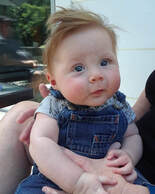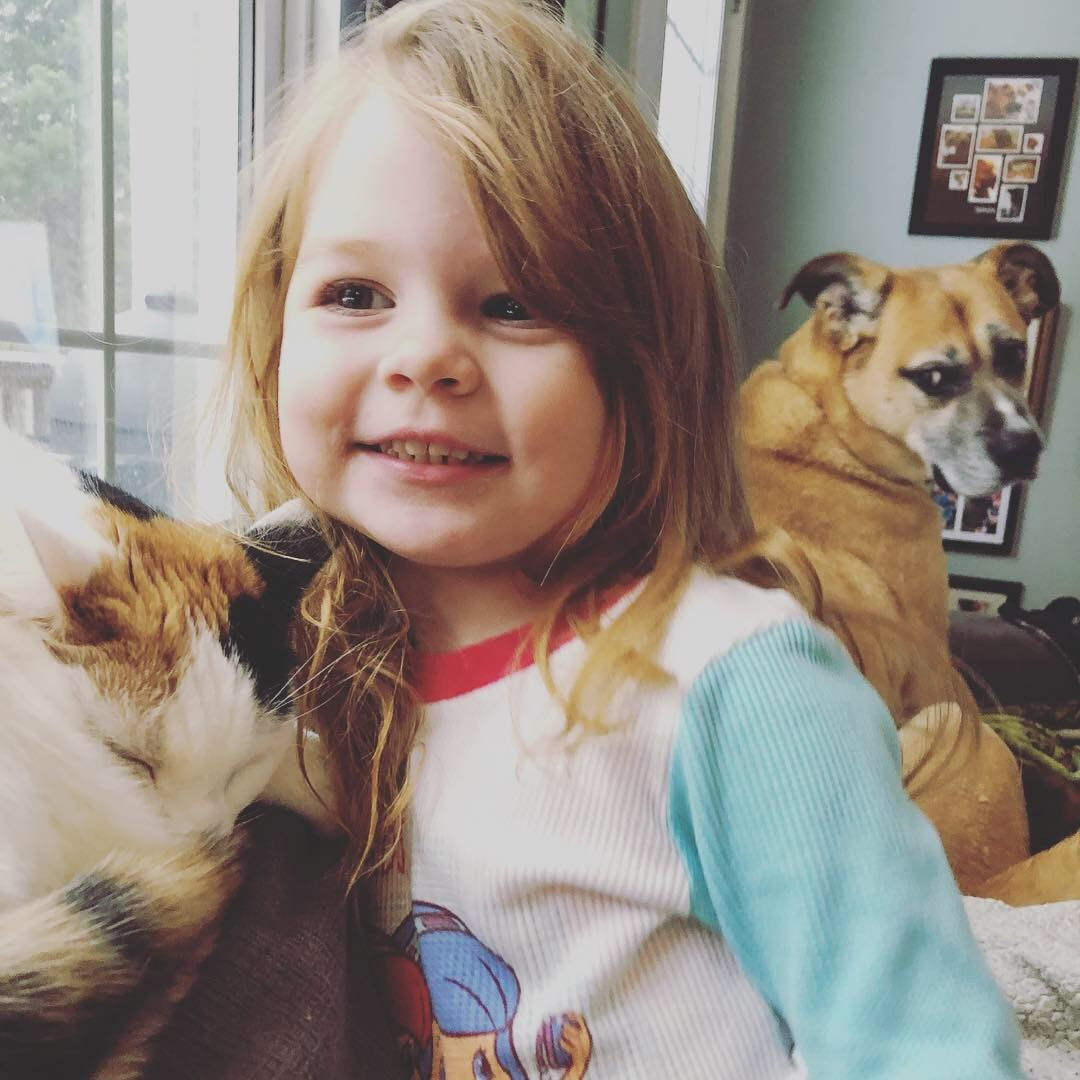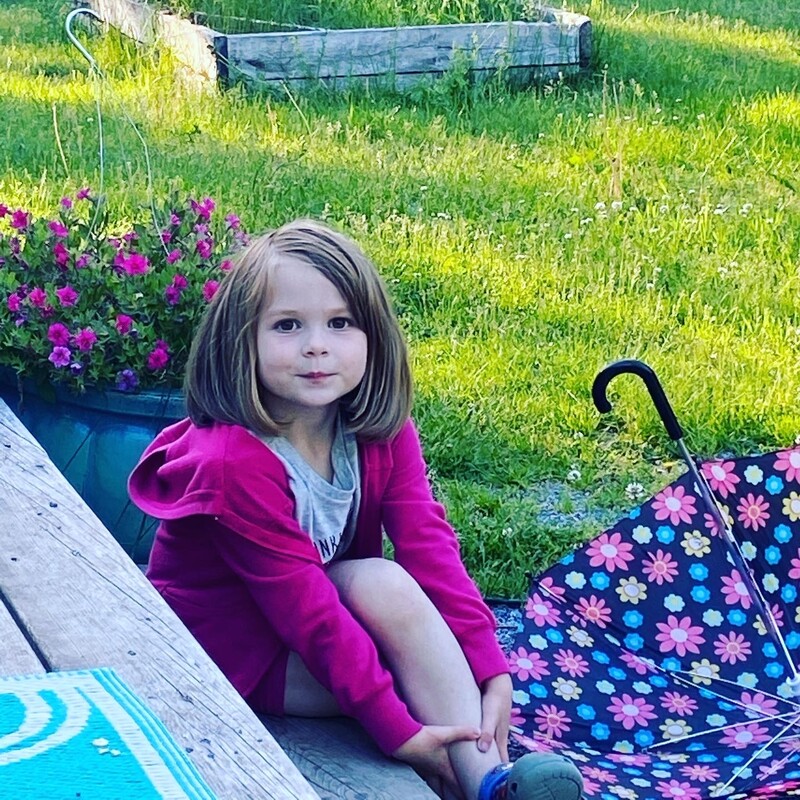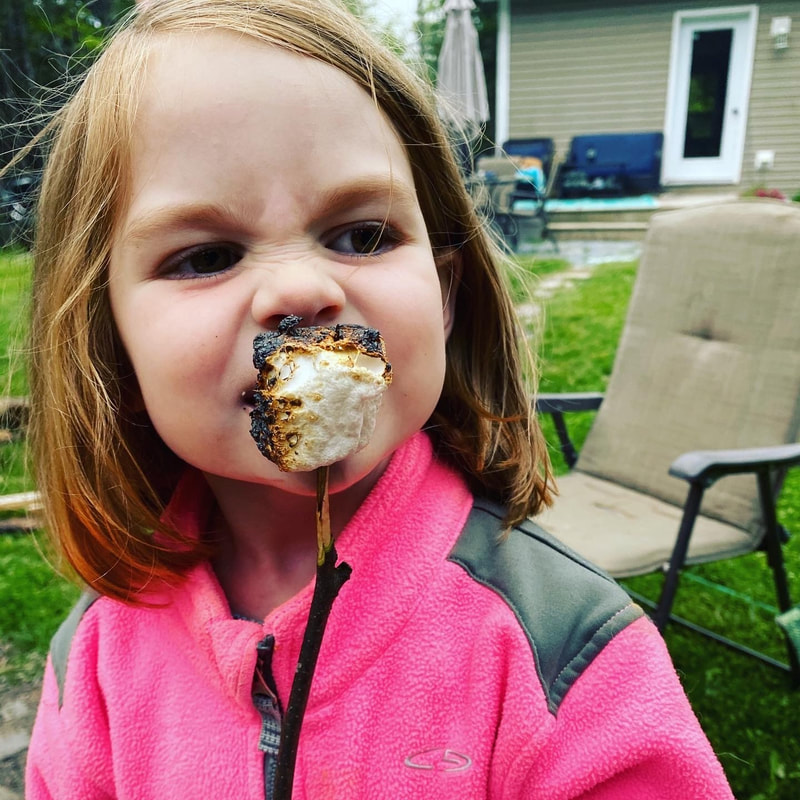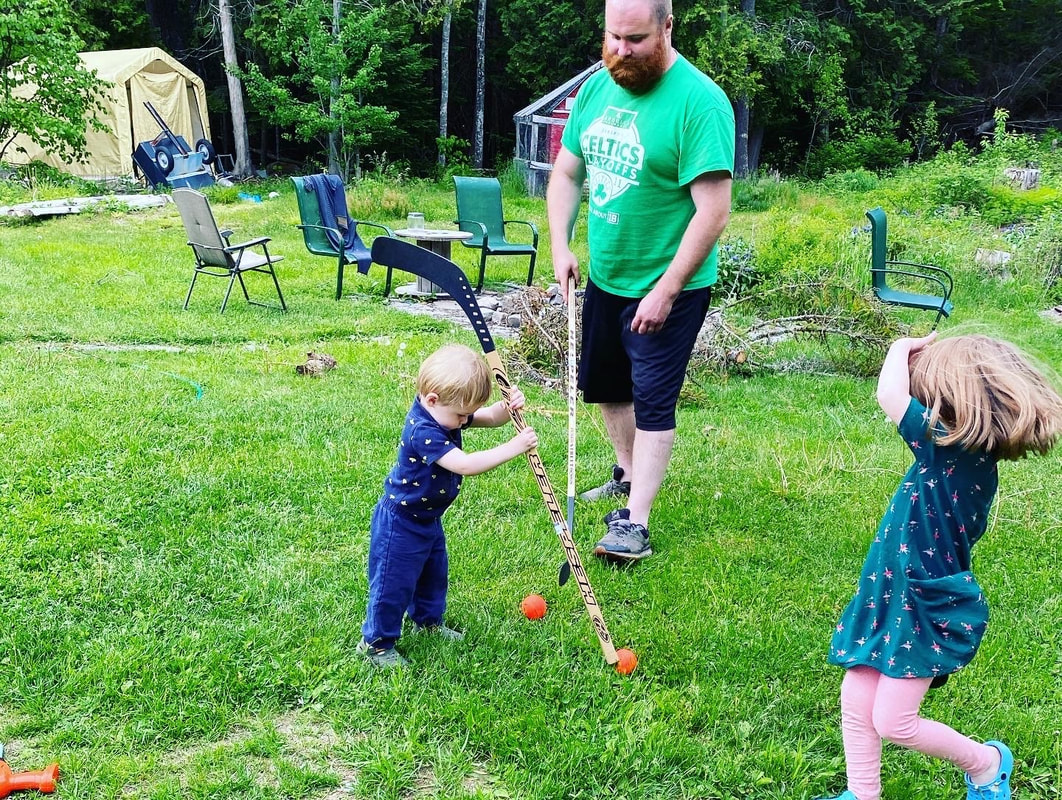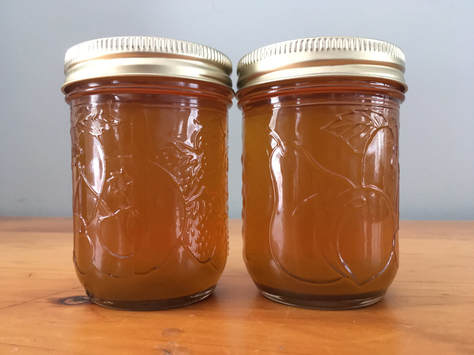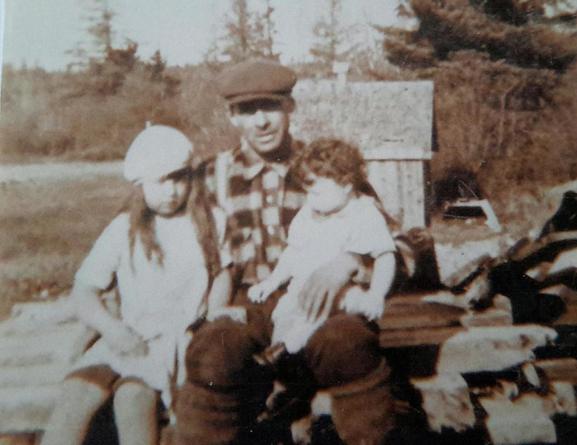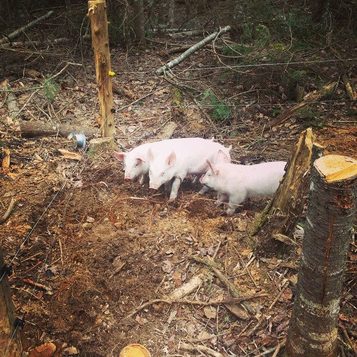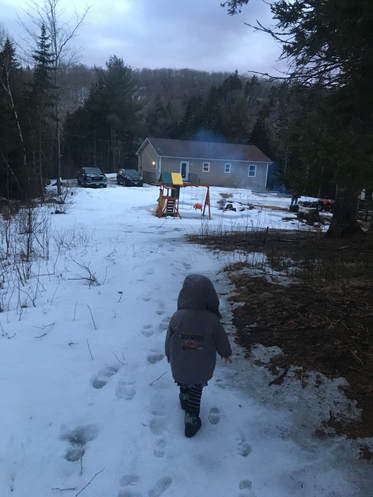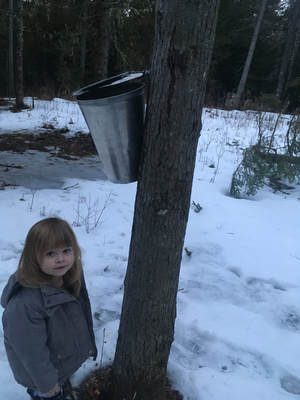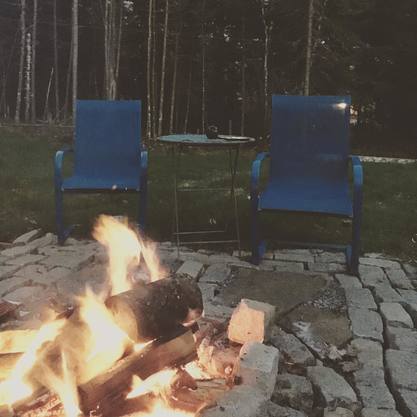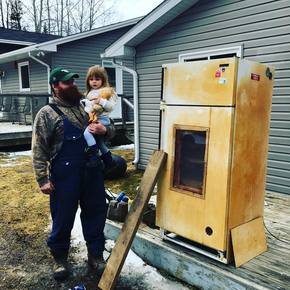Our Backyard: The 2020 Reboot
Backyard Maple
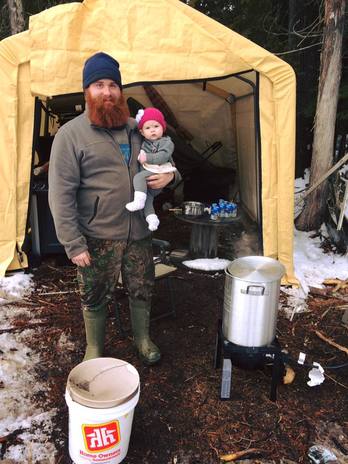 Adeline and her dad boiling sap, March 2016.
Adeline and her dad boiling sap, March 2016.
“You need to add butter,” he says. “When the sap starts to foam. It calms it down. Just a little.”
He’s been making maple syrup since we moved into our Kingston, New Brunswick home five years ago. Our first winter here, he started small, tapping several trees around our property, learning through experience and tips he found online: which trees to tap, how to boil it down, how best to preserve the maple syrup so we can have it all year round and pass some on to family.
This year he’s fashioned an old cast iron stove into an evaporator for sap, cutting out the top for the stainless steel pan, and adding a fan to keep the fire hot.
“It’s hard boiling today because it is windy and cold,” he explains.
This is exactly why I’ve kept my toddler, and myself if I am being honest, inside for most of the day. She’s been watching him all morning from our kitchen door, narrating everything he does.
“Him making hot--,” she looks to me for the word.
“He’s making a hot fire to boil the sap,” I tell her.
“Him making fire to make syrup for my pancakes!” she exclaims, and then dances around the kitchen island.
I don’t think she has quite grasped that boiling forty litres of sap to yield one litre of maple syrup takes patience and time. It won’t be until late tonight that we will get the first bottle, and she’ll be in bed before she’s getting pancakes, but maybe tomorrow.
“The syrup’s ready!” she yells. “Daddy is making the syrup for my pancakes, and it’s ready!”
There is more toddler dancing.
This is her exclamation every time he gets up, adds a log, stokes the fire, adds more sap to the pan, and does other tasks that is involved in the full day sap boil.
My role is still one of observer and keeper of toddler--because of the flames and boiling sap. I help out when things need done away from the fire, but mostly I watch, learn, and think about how the man I met eight years ago has changed significantly. Then, he was totally into snowboarding, where now he is a red-bearded man who raises chickens, pigs, and spends much of his weekends in March perfecting the art of boiling sap. Over the few years we’ve lived in Kingston, he has learned how to boil the sap so that it is not too thick, not too thin, but delicious and beautiful, and made from our backyard and in our backyard.
Later that night he brings what is left of the forty litres of sap into the house to finish on our stove. The wind and cold has made it a hard day of boiling, and the last hour can be done indoors. We marvel at the amber liquid. He snaps to it quickly when it starts to foam maniacally, settling it down with a little slick of butter, and eventually pouring the litre of syrup into two small mason jars.
“Will you boil again tomorrow? Or do you need to wait until you have more sap?” I ask.
“If it is a good week, I will get more to boil down on the weekend,” he explains.
This year he has about fifteen of our sugar maples tapped, and each night he goes around from tree to tree, checking the sap, filling a large bucket with the gains. I remember the year I was pregnant, it had snowed so heavily that he used snowshoes to get from tree to tree. By May, the snow had melted and the buckets were high up in the trees. He used a ladder to get them down. But this year, with such little snow, I can take Adeline around to the buckets, low enough for her to touch, and I show her the sap, dripping from the tree and into the bucket over the spile. She is only two, and maybe she won’t understand that this tree and her pancakes have so much in common, but someday she will.
“How long will you collect the sap?” I ask, curious and always a little in awe at this old custom played out in my backyard.
“As long at the days are warm and the nights are cold, and until the trees start to bud. That’s generally the season,” he explains. He’s short. He’s told me all this before. But, I ask a lot of questions.
I think about the corn syrup masked as maple in the grocery stores. Until recently, I really never thought much about the difference. I should have, though, as I’m from New Brunswick and it is our culture.
My grandmother, Velma Finnigan, ninety one and from Wirral, NB, loves hearing about these backyard homestead adventures. She grew up on a farm and she too had chickens and pigs. Her father tapped his trees for syrup. Her brother still lives on the land.
I call her up as the sap boils on our stove.
“Do you remember your father making maple syrup when you grew up?” I ask.
“Yes, I do. He used to tap the trees up on Birch Hill, and bring it all in for my mother to boil over the cast iron stove. It was hot in the house once the weather warmed, and I remember my mother saying it would take all day for just a little syrup,” my grandmother explains.
“Did he do enough to sell, or was it just for the family?” I ask, curious about her life on the farm.
“He only did it for us. It was hard work, and my mother had so many other things to do that using the stove for an entire day to make sure it turned out took a lot of work. She didn’t have running water, or electricity. She cooked all of our meals on that one stove, it took her all day to make a stew. So, they didn’t do the syrup much, just enough for our pancakes,” she says.
I can’t help but think of my grandmother, waiting all day for maple syrup for her pancakes like my daughter waited today. There may be 89 years separating them, but the custom of the maple syrup boil is exactly the same.
I remember going to Elmhurst Outdoors in Kingston, NB in the 1990s. I liked learning about it that day. The trees and the sap and all that boiling wowed me then as it does now. But today, I like the lesson of patience in the production of the syrup, something I missed on that one day trip to the wilderness. Thanks to my partner, I get to see the deliberate toil of progress: wait for the tree to produce the sap, hope for a good season, and then collect it all for the boil. It is slow. It is precise. It is rewarding. And I am thankful my partner has taken on this skill so that my daughter can learn from it.
Before my daughter goes to bed, I take her out for a last look at the boiling, just as her dad is getting ready to bring it in.
“It’s preddy,” she says. Pretty is still a tricky word at two.
“What’s that?” I ask.
She is on her swing in the backyard. It is snowing. The trees are blowing hard at the top, but down here on the ground it is calm, and the quiet is beautiful.
“This place!” she smiles.
She opens her arms up wide, closes her eyes, and breathes deep.
He’s been making maple syrup since we moved into our Kingston, New Brunswick home five years ago. Our first winter here, he started small, tapping several trees around our property, learning through experience and tips he found online: which trees to tap, how to boil it down, how best to preserve the maple syrup so we can have it all year round and pass some on to family.
This year he’s fashioned an old cast iron stove into an evaporator for sap, cutting out the top for the stainless steel pan, and adding a fan to keep the fire hot.
“It’s hard boiling today because it is windy and cold,” he explains.
This is exactly why I’ve kept my toddler, and myself if I am being honest, inside for most of the day. She’s been watching him all morning from our kitchen door, narrating everything he does.
“Him making hot--,” she looks to me for the word.
“He’s making a hot fire to boil the sap,” I tell her.
“Him making fire to make syrup for my pancakes!” she exclaims, and then dances around the kitchen island.
I don’t think she has quite grasped that boiling forty litres of sap to yield one litre of maple syrup takes patience and time. It won’t be until late tonight that we will get the first bottle, and she’ll be in bed before she’s getting pancakes, but maybe tomorrow.
“The syrup’s ready!” she yells. “Daddy is making the syrup for my pancakes, and it’s ready!”
There is more toddler dancing.
This is her exclamation every time he gets up, adds a log, stokes the fire, adds more sap to the pan, and does other tasks that is involved in the full day sap boil.
My role is still one of observer and keeper of toddler--because of the flames and boiling sap. I help out when things need done away from the fire, but mostly I watch, learn, and think about how the man I met eight years ago has changed significantly. Then, he was totally into snowboarding, where now he is a red-bearded man who raises chickens, pigs, and spends much of his weekends in March perfecting the art of boiling sap. Over the few years we’ve lived in Kingston, he has learned how to boil the sap so that it is not too thick, not too thin, but delicious and beautiful, and made from our backyard and in our backyard.
Later that night he brings what is left of the forty litres of sap into the house to finish on our stove. The wind and cold has made it a hard day of boiling, and the last hour can be done indoors. We marvel at the amber liquid. He snaps to it quickly when it starts to foam maniacally, settling it down with a little slick of butter, and eventually pouring the litre of syrup into two small mason jars.
“Will you boil again tomorrow? Or do you need to wait until you have more sap?” I ask.
“If it is a good week, I will get more to boil down on the weekend,” he explains.
This year he has about fifteen of our sugar maples tapped, and each night he goes around from tree to tree, checking the sap, filling a large bucket with the gains. I remember the year I was pregnant, it had snowed so heavily that he used snowshoes to get from tree to tree. By May, the snow had melted and the buckets were high up in the trees. He used a ladder to get them down. But this year, with such little snow, I can take Adeline around to the buckets, low enough for her to touch, and I show her the sap, dripping from the tree and into the bucket over the spile. She is only two, and maybe she won’t understand that this tree and her pancakes have so much in common, but someday she will.
“How long will you collect the sap?” I ask, curious and always a little in awe at this old custom played out in my backyard.
“As long at the days are warm and the nights are cold, and until the trees start to bud. That’s generally the season,” he explains. He’s short. He’s told me all this before. But, I ask a lot of questions.
I think about the corn syrup masked as maple in the grocery stores. Until recently, I really never thought much about the difference. I should have, though, as I’m from New Brunswick and it is our culture.
My grandmother, Velma Finnigan, ninety one and from Wirral, NB, loves hearing about these backyard homestead adventures. She grew up on a farm and she too had chickens and pigs. Her father tapped his trees for syrup. Her brother still lives on the land.
I call her up as the sap boils on our stove.
“Do you remember your father making maple syrup when you grew up?” I ask.
“Yes, I do. He used to tap the trees up on Birch Hill, and bring it all in for my mother to boil over the cast iron stove. It was hot in the house once the weather warmed, and I remember my mother saying it would take all day for just a little syrup,” my grandmother explains.
“Did he do enough to sell, or was it just for the family?” I ask, curious about her life on the farm.
“He only did it for us. It was hard work, and my mother had so many other things to do that using the stove for an entire day to make sure it turned out took a lot of work. She didn’t have running water, or electricity. She cooked all of our meals on that one stove, it took her all day to make a stew. So, they didn’t do the syrup much, just enough for our pancakes,” she says.
I can’t help but think of my grandmother, waiting all day for maple syrup for her pancakes like my daughter waited today. There may be 89 years separating them, but the custom of the maple syrup boil is exactly the same.
I remember going to Elmhurst Outdoors in Kingston, NB in the 1990s. I liked learning about it that day. The trees and the sap and all that boiling wowed me then as it does now. But today, I like the lesson of patience in the production of the syrup, something I missed on that one day trip to the wilderness. Thanks to my partner, I get to see the deliberate toil of progress: wait for the tree to produce the sap, hope for a good season, and then collect it all for the boil. It is slow. It is precise. It is rewarding. And I am thankful my partner has taken on this skill so that my daughter can learn from it.
Before my daughter goes to bed, I take her out for a last look at the boiling, just as her dad is getting ready to bring it in.
“It’s preddy,” she says. Pretty is still a tricky word at two.
“What’s that?” I ask.
She is on her swing in the backyard. It is snowing. The trees are blowing hard at the top, but down here on the ground it is calm, and the quiet is beautiful.
“This place!” she smiles.
She opens her arms up wide, closes her eyes, and breathes deep.
Our Story of Three Little Pigs
|
In May, the pigs are ordered. When they arrive, they are small and sweet, and my former vegetarian heart struggles with their fate. In the summer of 2017 we raised our third set of pigs. Three pigs each year, raised from piglets in the summer to 250 pound pigs in the Fall, find a temporary home on our three acre property in Kingston, NB.
We moved to the Peninsula in 2013. Our MLS search requirements were simple: land and can we get chickens? Five years later, not only do we have chickens, but each year we raise three pigs in our backyard. The first summer we raised the pigs I was pregnant. As the summer progressed and my belly grew, I’d amble up the path each day and water the pigs. Now, if you would like to challenge your balance, carry a bucket of water over an electric fence with a third trimester belly. By October, Fall cooled the air, and I watched from the house, holding my one month old as my partner and our friend attempted to corral three giant pigs onto the trailer. I struggled that first time to reconcile the pigs I’d nurtured for months, with the food I’d prepare for my family. |
Adeline in Our BackyardThat first year was a steep learning curve for me. Not five years before I was a vegetarian who dabbled in veganism. I still had a hard time with meat, and the idea of raising our own food was my partner’s dream not mine. But we had a child and she would start to understand that the pigs we had in our yard ended up in our meals. I ate meat now, and so I started to embrace the practice of raising our own food. I gave them water. I brought them scraps from lunch and dinner. I watched them over the summer as they grew and grew. And then I watched, each year as they were towed away.
|
As I started to develop the narrative I would use to explain to my child, who would inevitably ask about the pigs and understand where the pork from her plate came from, I started to see the beauty in it for myself. I know everything they eat. They are cared for. They have a large place to roam and sleep and play. And when it is time, we have food with roots in our land.
Ten years ago, I moved back to New Brunswick after four years in New York City and Toronto. I never intended to be a rural dweller. I certainly didn’t think I’d live in a place where I could barely see our one neighbour. But on a clear summer night, when I sit out at our campfire and I look up into the sky, I know my decision to leave the city was the best for me. And now I want my daughter to experience everything our small piece of land can offer her. We bring her to feed the pigs, she runs after the chickens in the yard, she digs in the gardens, she investigates the maple syrup supply, and yes, she even helps her dada smoke the bacon. |
Proudly powered by Weebly
